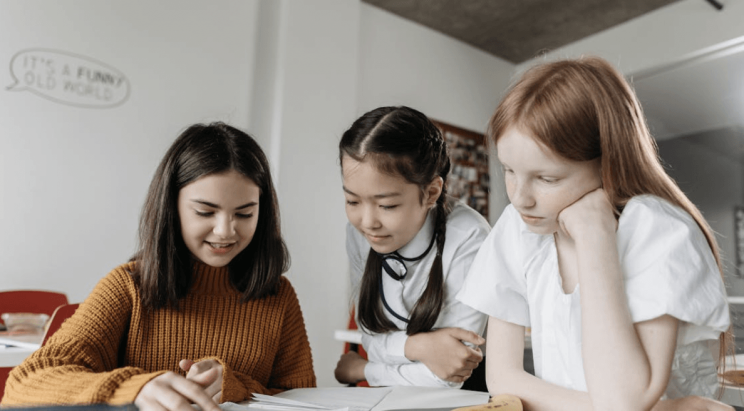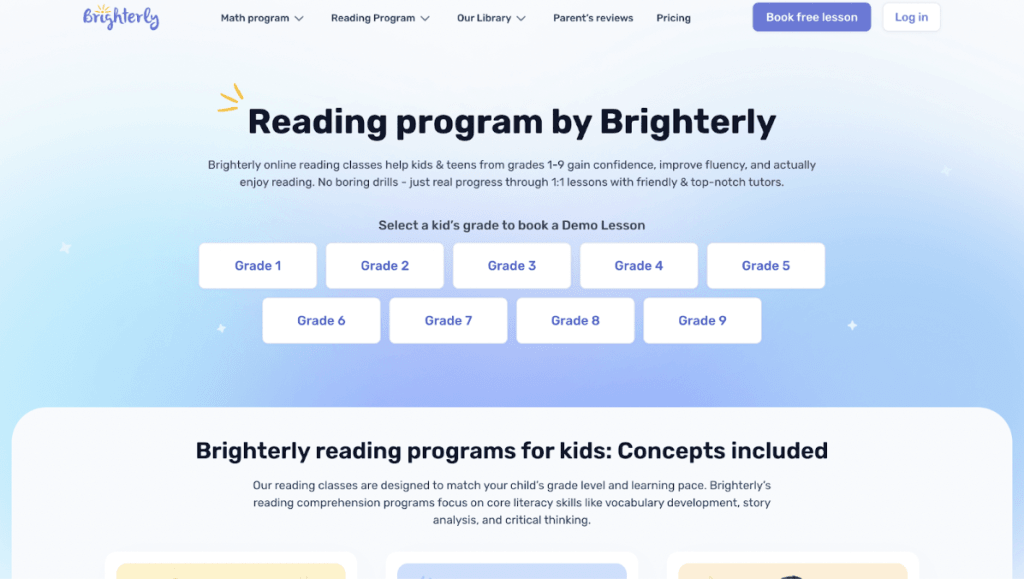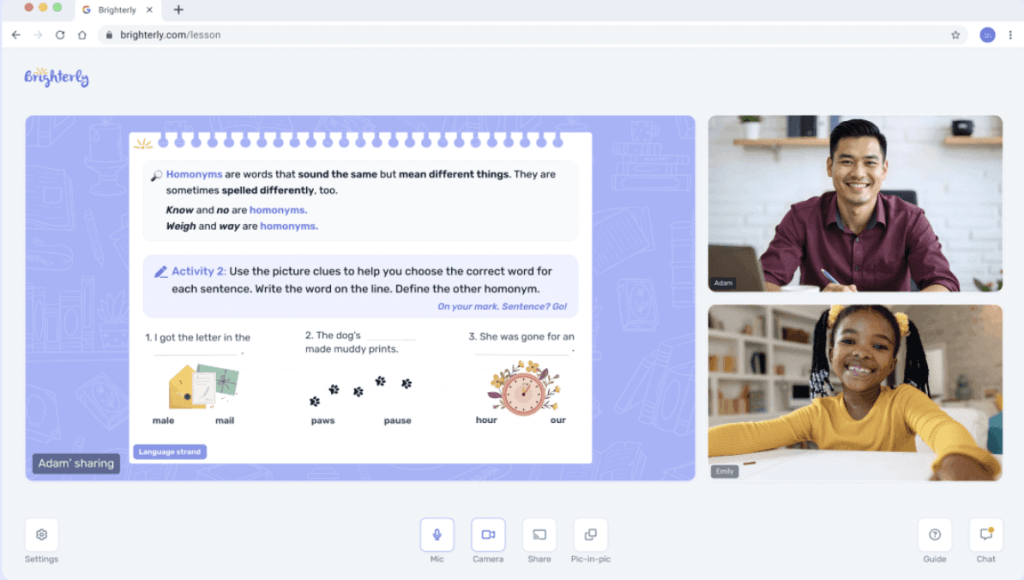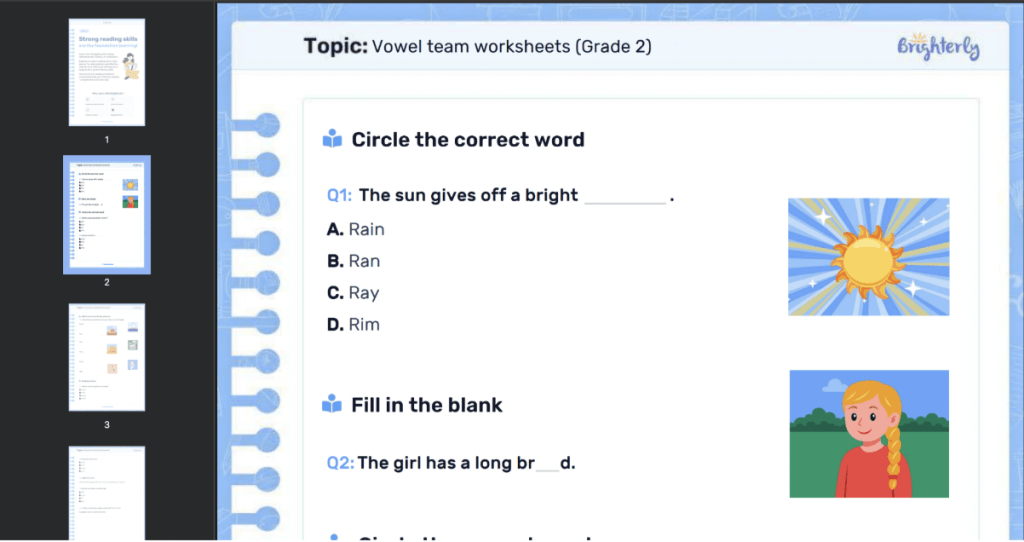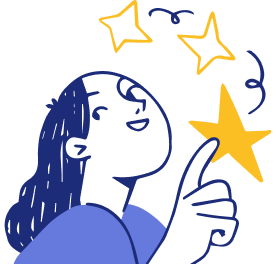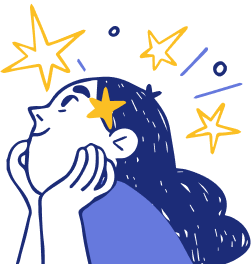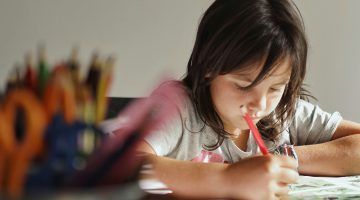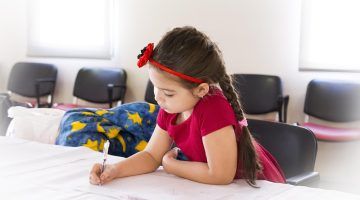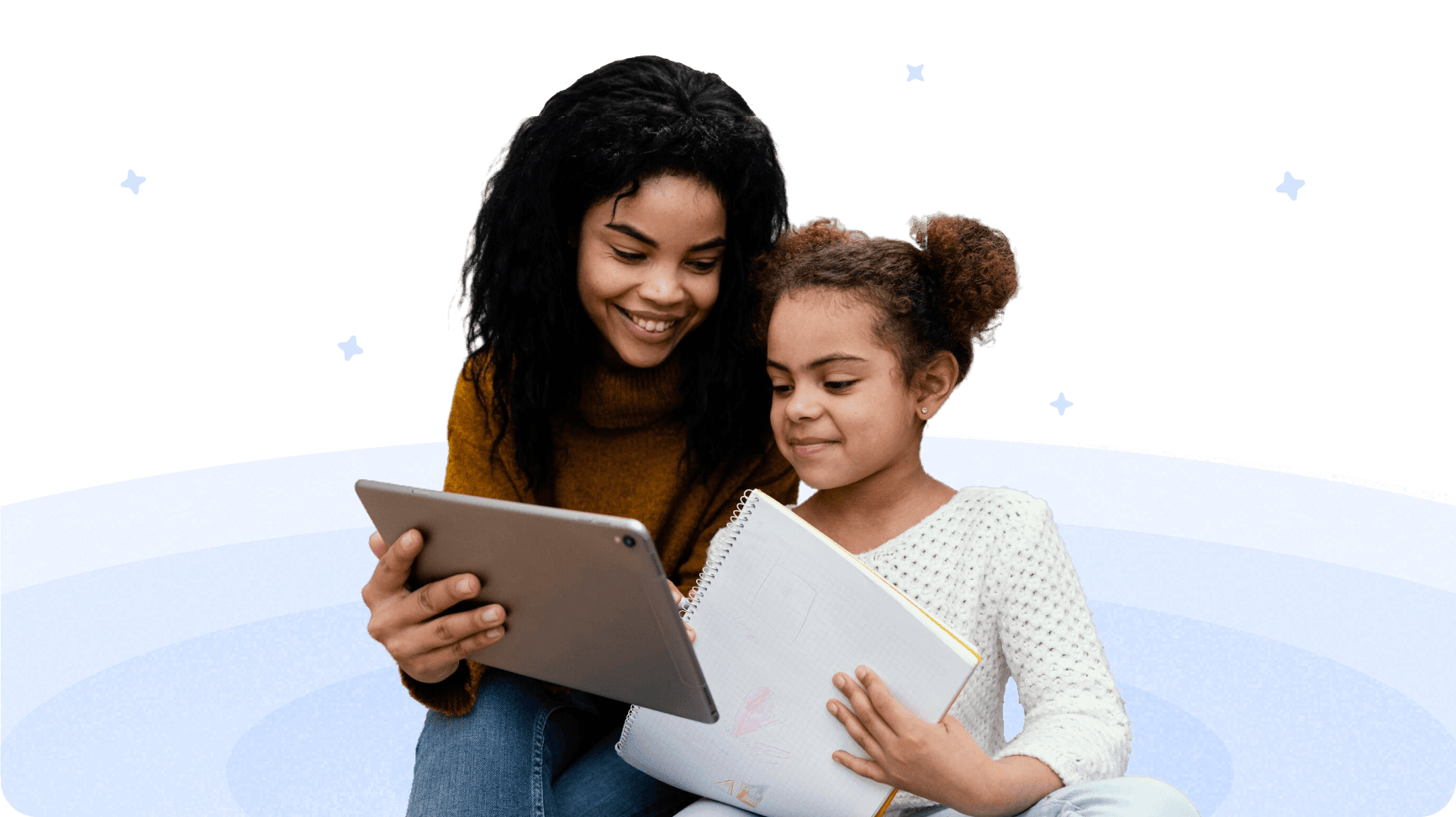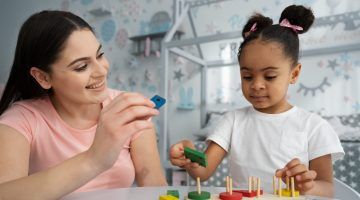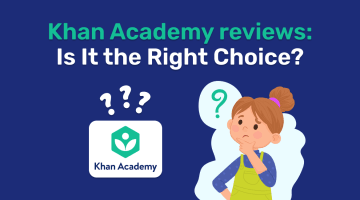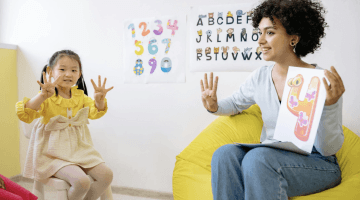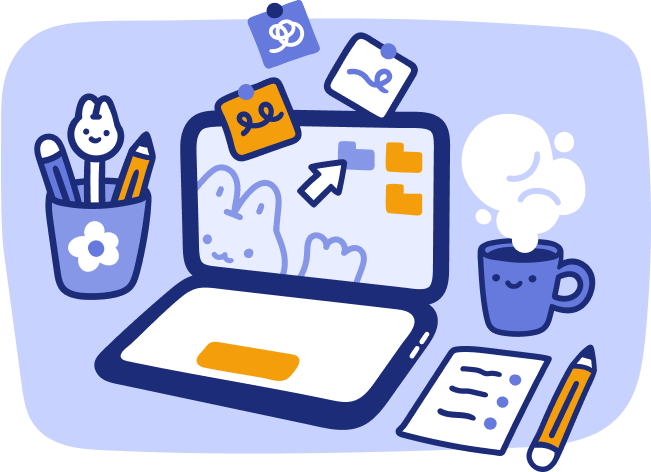Literacy Development: A Complete Guide for Parents and Educators
reviewed by Marvi M. Andres
Updated on October 19, 2025
If you’re teaching children to read, it’s vital that you know how literacy development works. With the understanding of the process of learning words, sounds, and language, plus the stages of literacy development they move through, you can support them more effectively.
I’m a reading tutor with Brighterly, and in this article, I will walk you through everything you need to know about literacy development in 2025.
Key points
- Literacy development starts even before children are able to speak.
- There are five stages of literacy development, and they are all equally important.
- Brighterly is a math and reading platform for children in grades 1–9 that uses literacy development stages and the Science of Reading principles to teach kids reading.
What is literacy development?
Literacy development definition is when children learn to read, write, and understand language. It begins early with exposure to sounds and words and progresses to fluent reading and writing.
Note: Children don’t just learn how to read, write, and understand language. It is through listening, talking, and playing that they build literacy in early childhood. But, without consistent exposure to rich language experiences, such as reading aloud, conversation, and storytelling, their skills may develop unevenly.
5 stages of literacy development
- Emergent literacy (birth to preschool)
- Early reading and writing (kindergarten to Grade 1)
- Transitional reading and writing (Grades 2–3)
- Fluent reading and writing (Grades 3–4)
- Advanced literacy (Grade 5 and beyond)
Note: Early literacy development isn’t built in a day. It unfolds step by step, with every new sound, word, and bedtime story. The more meaningful experiences that connect speech and comprehension a child has, the better their literacy development progresses.
Let’s look in more detail at these five phases of literacy development – how kids experience them, what they need, and how we can help them.
Emergent literacy (Birth to preschool)
Little kids develop literacy before they’re even able to understand language. It is through play, sounds, and everyday activities that literacy development in early childhood is built.
First, children start to recognize familiar voices, listen to nursery rhymes, and observe picture books. Parents see them flipping pages upside down or scribbling on paper. Those adorable moments are the earliest signs of literacy awareness.
What they do at this stage
- Recognize logos and signs (stop sign, McDonald’s logo, etc.)
- Show interest in books and turning pages
- Experiment with drawing and writing
- Develop vocabulary via listening and talking
How parents/educators can help
- Reading aloud daily. Short, rhyming picture books are the best, but any children’s story will do wonders as well.
- Sing songs and recite rhymes. This strengthens sound recognition and boosts comprehension.
- Play pretend. Made-believe social settings, like going to a restaurant, are an optimal way to use language.
- Let kids choose books-keep them at their eye level and encourage them to select what to read.
💡Tip from a tutor: Early literacy development means your preschooler may “read” from memory. That’s actually an early form of fluency. That way, they’re practicing narrative patterns and learning that stories have a beginning, middle, and end.
Early reading and writing (Kindergarten to grade 1)
At this stage, magic happens – kids start connecting letters and sounds, and their phonemic awareness improves. They realize that written words mirror spoken language. For example, they start understanding that the word “cat” consists of three sounds blended together: /k/ /a/ /t/.
What they do at this stage
- Write their names and simple words
- Know most letters of the alphabet
- Begin to blend simple letter sounds to read words
- Use inventive spelling (like “frend” for “friend”)
Note: Reading their first words on their own is a huge accomplishment-supporting literacy development in the early years by showing how good they did.
How parents/educators can help
- Use letter blocks, sound games, or magnetic letters to make phonics fun.
- Write a ton together. Even if they misspell constantly, celebrate their writing.
- Games like “word hunts” are perfect to learn the alphabet.
- Continue reading stories together. It’s not just for toddlers. Switch from picture books to early chapter books or short story collections.
💡Tip from a tutor: Make your kids feel safe to read. Literacy at 5 years old is not about perfection, oh no. It’s about confidence when they stumble; it’s a learning curve, not a mistake.
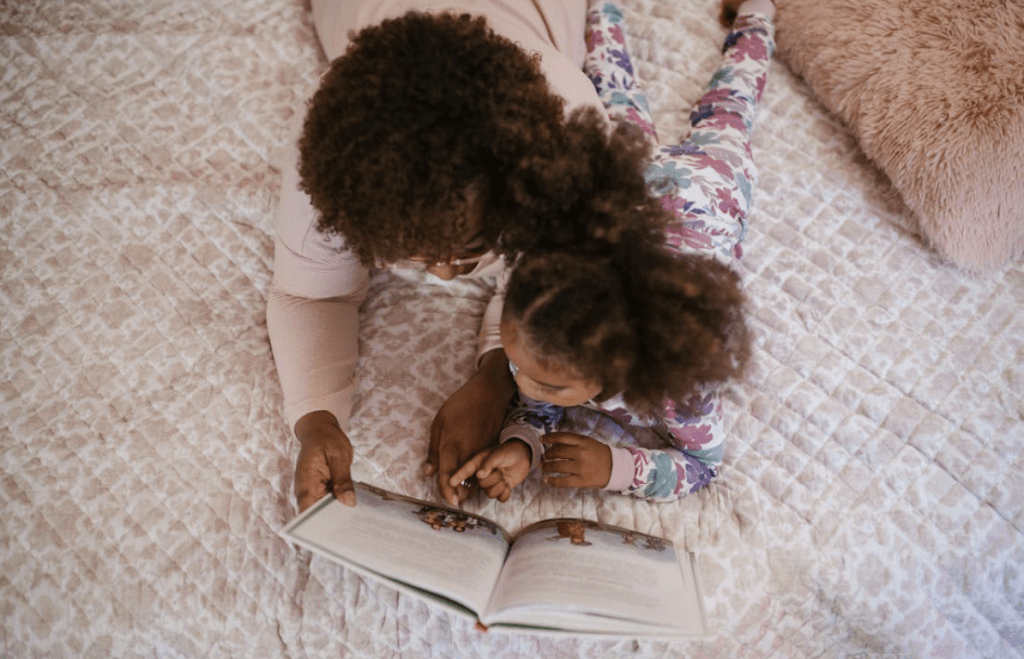
Transitional reading and writing (Grades 2–3)
More advanced children’s reading development kicks off in the 2nd grade. Now, the child starts connecting sounds and understanding. Reading becomes more familiar, smoother, and comprehension starts to blossom. At this stage, kids can decode longer words. begin reading for meaning rather than sounds, and recognize sight words (“the”, “said”, “where”).
Children begin to write, and they progress from single to full sentences. Their stories suddenly have characters, settings, and emotions.
What they do at this stage
- Read simple storybooks independently
- Use punсtuation and spacing in writing
- Revise or edit their homework
- Understand the main idea in stories
- Expand vocabulary through reading
How parents/educators can help
- Discuss stories together. Ask them questions like “What drove the character to act this way?”
- Motivate them to write notes, short letters, or even mini-stories if they feel like it.
- Encourage daily reading. It is important to let them pick books or stories they want to read.
💡Tip from a tutor: If they’re stuck on familiar stories, don’t rush them into chapter books. It is completely normal for their age, just like a musician practices scales before a recital.
Fluent reading and writing (Grades 3–4)
In grades 3 and 4, children are no longer focused on decoding every sound. Reading becomes more automatic, and kids are more interested in ideas and concepts. Some begin to read for pleasure and learning, and their vocabulary expands quickly. With literacy and language development in grades 3 and 4, they can summarize and analyze more difficult texts.
Writing is another skill they improve. At this point, it becomes more structured and expressive, and they also plan their writing, use the right grammar, and punctuation.
What they do at this stage
- Read longer texts and comprehend them well
- Study educational materials to learn subjects like science, etc.
- Write organized paragraphs
- Use and understand figurative language
How parents/educators can help
- Ask them open-ended questions when you’re done with reading (“What did you understand from that story?”).
- Encourage some creative writing.
- Present them with a variety of genres and encourage reading for pleasure.
- Connect reading to real-life scenarios, like reading recipes, instructions, etc.
💡Tip from a tutor: This stage’s process of reading development involves a motivation dip. Homework may feel heavy, and kids may feel confident enough in their reading. This is where it’s important to keep the momentum alive with comics, audiobooks, or magazines.
Advanced literacy (Grade 5 and beyond)
In grade 5 and beyond, literacy development for kids revolves around building real literacy independence. Children become more independent and able to read complex materials, express opinions, analyze ideas, and more. They develop their unique perspective. Now, they read more for insights rather than facts.
In reading, advanced students can compare themes across various texts, understand expressions, and metaphorical language. And when it comes to writing essays, reports, persuasive pieces, and creative storytelling come into play.
What they do at this stage
- Reading critically and evaluating complex texts
- Gathering information from multiple texts
- Writing with a clear structure
- Using a more advanced vocabulary
- Forming independent opinions and discussing ideas
How parents/educators can help
- Encourage debates and book discussions at home.
- Add age-appropriate current events and nonfiction texts.
- Help with research and citation – these are important skills for high school
- Read together sometimes. This is a great opportunity to bond for parents and kids.
💡Tip from a tutor: You always share some interesting blog posts, short stories, or even songwriting. Development of reading skills does not mean just textbooks; it’s more about communication, some psychology, and storytelling.
By the by, if you want to know more useful hacks or interesting facts about reading, you can check two articles: How to teach kids to read and Reading scores statistics in 2025, both written by reading experts.
Understanding literacy development stages with Brighterly
Brighterly math and reading platform is an e-learning platform for students in grades 1–9 that connects American students with expert math and reading tutors. The Brighterly platform helps kids close their learning gaps and improve their academic performance through affordable private tutoring.
Last year alone, over 200,000 parents joined Brighterly, achieving an average Trustpilot rating of 4.4 stars, which is excellent by the standards of review websites. Brighterly uses the Science of Reading principles and the stages of literacy development to adapt their teaching style to each student, promoting great reading results.
Brighterly’s key features
fExpert-driven tutors
The Brighterly platform only collaborates with experienced tutors who are highly trained professionals in reading and math subjects. Each potential candidate undergoes a rigorous evaluation that includes a background check, and only the best tutors are accepted.
Brighterly’s reading tutors adapt their methods to each kid, whether it’s just closing learning gaps, helping with phonological awareness, improving fluency, or combining everything; they know which teaching techniques are best in every particular situation.
School-aligned curriculum
Brighterly reading program curriculum is fully school-aligned and adheres to the US state standards. Don’t know what this means? Let me explain.
The platform ensures that everything your child learns during a 1:1 lesson with Brighterly matches what they’re expected to learn in school. So, in essence, your child reinforces classroom skills while filling knowledge gaps through fun, adapted lessons that follow the state’s benchmarks and recommendations.
Free learning resources
Free learning resources available to all learners are what Brighterly is famous for. If you’re looking for comprehensive learning resources for solo learners – Brighterly is the place to get them! Materials like reading worksheets and reading tests are free printable PDFs that are available to you with no credit card or sign-up required.
How does Brighterly compare to other reading platforms?
Ignite Reading |
Brighterly |
Learning Ally |
|
| Trustpilot rating | Not available | 4.4/5 | Not available |
| Best for | Elementary | Grades 1–9 | Grades 1–12 |
| Focus | Reading | Reading, Math, ELA | Reading |
| Standout features | Daily 15-minute 1:1 lessons through a scripted program |
Reading & Math lessons, Award-winning curriculum, Math and reading worksheets Math and reading tests |
For disabilities like dyslexia College support Homeschool resources Family literacy toolkit Audiobooks for students with reading disabilities |
| Personalization | No | 👍 | No |
| Student pays | From $2,500 per student per year | From $17.3/lesson | $135/year |
As you can see, Brighterly is the only platform that offers full-on private, personalized lessons that are fully adapted to each child’s learning pace and learning gaps. While other platforms provide pre-recorded lessons and limited 1:1 time, the Brighterly tutors guide students step by step, ensuring real engagement.
Plus, Brighterly is not limited to reading; it combines reading, math, and overall literacy skills into a cohesive learning experience.
What is literacy development in early childhood?
Literacy development in early childhood is the process through which younger children learn to understand, engage with, and enjoy language. It starts from birth and progresses up until the 12th grade. It involves developing a love for reading and language through everyday activities like talking, singing, and reading aloud together.

Early literacy development stages
- Between the ages of 6 months and six years old, kids learn to reproduce sounds, form words, and represent concepts.
- At ages 6 and 7, they match letters and sounds and start to connect printed and spoken words. They can also read and write individual letters.
- Between ages 7 and 9, kids finally gain fluency in reading. They become able to decode words and sentences and build their vocabulary through reading.
Literacy development activities
Literacy development activities for the emergent literacy stage
- Reading aloud is an absolute must.
- Use silly voices, rhymes, and repetition.
- Sing nursery songs.
- Talk about pictures in books, instead of just saying the words.
Note: Early childhood literacy development is about exposure and play. As a parent and/or educator, your task is to involve kids in fun, everyday activities as much as you can.
Literacy development activities for kindergarten to grade 1
- Use magnetic letters to build simple words.
- Read simple picture books.
- Encourage your kid to read along.
- Play “I Spy” with beginning sounds (“I spy something that starts with A!”).
At this stage, kids start to connect letters and sounds, and, yes, you guessed it! You need to make it fun.
Literacy development activities for grades 1–2
- Ask children open-ended questions (“Why do you think it happened?”).
- Draw comics to encourage creative writing.
- Start to read early chapter books together. You can take turns reading them aloud.
- Introduce rhyming games and word families.
At this stage, kids begin to decode with more ease, but they still work on their comprehension. I hope these literacy development examples for grades 1–2 will help you.
Literacy development activities for grades 3–4
- Encourage journaling (daily reflections, plans, etc.).
- Start a family book club and discussions.
- Write letters and emails.
- Explore new genres together (poetry, short stories, scene articles).
- Play word games.
When kids enter this literacy development stage, their reading becomes smoother, and they feel more confident in their writing.
Literacy development activities for grade 5 and beyond
- Encourage children to read newspapers, age-appropriate novels, articles, and everything they are interested in.
- Discuss news or real-world topics and ask for their opinion.
- Support writing essays or creative writing projects.
- Develop research skills and how to find reliable sources to summarize information.
Even though 5th grade is still early for real depth, children make their first steps in analyzing, evaluating, and expressing ideas, stepping into a more advanced literacy level.
Conclusion
All in all, parents and educators must be aware of the literacy development stages in order to opt for the right tools and exercises to boost their reading and writing. Without consistent exposure to rich language experiences, children won’t be able to evenly develop their skills.
Finally, if you’re looking for a platform that combines all the good reading techniques, as well as:
- Transparent and affordable pricing
- Expert-driven tutors
- Best reading program that is fully school-aligned
Then Brighterly is your best ally! Click the link to book free reading lesson, and explore how reading for kids can be enjoyable!

